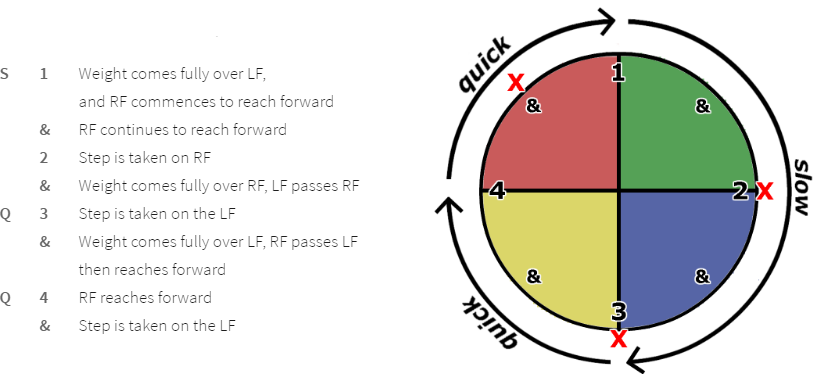Foxtrot Timing 
26 October 2016
Do you know the timing for a Feather Step? Most would say SQQ, but what does that really mean? A slow lasts two beats, which in Foxtrot is about a full second, but at what point in that second does the heel strike the floor? At what point is weight taken onto the foot? Is that always the case? These are important questions for any dance, but today we will examine the specifics of Foxtrot, because the answers to these questions have changed drastically in recent years, and some top tier dancers think they are doing one thing while they are actually doing something entirely different.
Breaking Down the Beats
Many of the most fundamental Foxtrot figures, such as the Feather Step, the Reverse Turn, and the Telemark, use the basic timing SQQ, where Slow lasts two beats and Quick lasts one. This can be seen in the graphic below.

Note that The first beat starts at the top of the circle, and lasts all the way until the second beat starts. When we talk about the beat, sometimes we are taking about the very beginning of the beat, when the drumstick hits the drum, but in fact the beat continues all the way until the next time the drumstick hits the drum. This interval of time is shown in the graphic above by different coloured quadrants.
Traditional Timing
Traditionally on a forward step, the foot is sliding on the floor, reaching forward before the beat, and then right at the beginning of the beat the foot stops moving, and the step can be said to have been taken. However long the step lasts, half that time is taken to get the weight over the foot, so that at the half way point the weight is directly over the foot, and the other half to move the weight past the foot in preparation for the next step. Therefore, the steps and weight transfer for the Man's part of the Feather Step would look like this, where the red X indicates a step being taken.

As you can see above, traditionally, the step is taken at the very beginning of the beat. However long the step lasts, weight always take 50% of that time to get over the foot, and the other 50% to pass beyond the foot. This ensures the body moves smoothly through the step.
New Timing
Recently, a new timing has emerged for when the step is taken and the weight is transferred. This emerged a generation ago, and now many of the top tier dancers use this timing, though some of them are not aware they do it, having themselves been taught by traditionally trained dancers.
In this timing, the Slow is broken up differently, so that the step isn't even taken until the halfway point, after which the weight needs to be transferred quickly. During the first half of the Slow, weight is held on the previous leg, and the moving leg is stretched forward to take a longer step. The second step is the same, but the third step occurs slightly later in order to accommodate the amount of time that needs to be spent on it before the following Slow. Here is what it would look like this, where the red X indicates a step being taken.

Essentially what has happened here is that the amount of time spent on the RF during the Slow has been cut in half, with with that half itself being split between two places: the time between step 2 and 3, and the time between step 3 and the next step 1. All the same processes have to happen with each step, but now there is less time to do them on the first step, and more time to do them elsewhere.
Comparison
Many great dancers use the new timing, but many great dancers still use the traditional timing, and still others use both, depending on the situation. There is no superior method, but each method will look different on different dancers, and when used at different times.
The traditional method has a strong weight transfer on the first beat, and as you know from the Musicality and Phrasing article back in March, the first beat is musically the strongest and the most important beat to hit. The Slow is also typically where most things happen. In the Reverse Turn, for example, the Lady has to dance a Heel Turn, which is made all the more difficult by shortening the amount of time dedicated to the Slow.
The new method, however, allows for a smoother gliding action throughout the figure. Go back to the circle above, and notice how each step is as evenly placed around the circle as possible. Furthermore, increasing the time between the second and the third step allows for the appearance of hanging in the air on the second step, which is one of the most characteristic movements in the dance.
Take a look at this Professional Foxtrot competition from last year, where most of the current top couples in the world are present. Notice the ones that use the traditional timing and those that use the new timing.
Lastly, try both of these timings for yourself. You may find that you think you do one, but actually do the other, or you may find that changing the one you use makes your dancing instantly look and feel better.